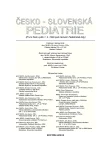Current Trends in the Treatment of Invagination in Childhood
Authors:
R. Štichhauer 1; J. Koudelka 1; P. Rejtar 2
Authors‘ workplace:
Oddělení dětské chirurgie a traumatologie, Fakultní nemocnice Hradec Králové
primář MUDr. J. Koudelka, CSc.
1; Radiologická klinika, Fakultní nemocnice Hradec Králové
přednosta prof. MUDr. P. Eliáš, CSc.
2
Published in:
Čes-slov Pediat 2010; 65 (11): 634-638.
Category:
Original Papers
Overview
Aim:
Evaluation of outcomes in patients diagnosed with invagination over an eight-year period with a focus on hydrostatic disinvagination performed under general anesthesia.
Material and methods:
In 2000–2008, 86 children diagnosed with invagination were treated at the Department of Pediatric Surgery and Traumatology in Hradec Králové. Retrospective medical record data were used to analyze in particular diagnostic and therapeutic protocol, treatment outcome and recurrence (if any) with a focus on hydrostatic disinvagination performed under general anesthesia.
Results:
Most (74.4%) of the 86 study patients were males. The majority of cases were diagnosed in infants and toddlers. Predominant symptoms were restlessness and abdominal pain, observed in 99% of cases. Enterorrhagia was reported in 45.3% of patients. Invagination was most often located in the ileocolic area. The diagnostic method of choice was ultrasonography, followed by hydrostatic disinvagination, when needed, performed under X-ray or ultrasonography guidance. The successful outcome rate was close to 77%.
The successful outcome rates of hydrostatic disinvagination were 78.8% when performed under general anesthesia and 81.1% when performed without general anesthesia. The most frequent surgical procedures were disinvagination and appendectomy. Recurrence was reported in 9.3% of patients. Hydrostatic disinvagination in patients with recurrence led to successful outcomes in 71% of cases. No death was recorded.
Discussion and conclusion:
Based on our data, general anesthesia does not increase the successful outcome rate of hydrostatic disinvagination. Nevertheless, it provides evident benefits in terms of procedure safety and comfort for the patient and surgical team.
Key words:
invagination, sonography, hydrostatic disinvagination, surgery, anesthesia, recurrence
Sources
1. Chang HG, Smith PF, Ackelsberg J, et al. Intussusception, rotavirus diarrhoea and rotavirus vaccine. Pediatrics 2001; 1 : 54–60.
2. Young DG. Intussusception. In O’Neill JA Rowe MI, Grosfeld JL, et. al. Pediatric Surgery. 5th ed. St. Louis: Mosby, 1998 : 1185–1198.
3. Cserni T, Paran S, Puri P. New hypothesis on the pathogenesis of ileocecal intussusception. J. Pediatr. Surg. 2007; 42 : 1515–1519.
4. Humbyrd CJ, Baril DT, Dolgin SE. Postoperative retrograde intussusception in an infant: a rare occurrence. J. Pediatr. Surg. 2006; 41: E13–E15.
5. Ramazan K, Kaan S, Zafer T, et al. Mucosa-associated lymphoid tissue lymphoma in the appendix, a lead point for intussusception. J. Pediatr. Surg. 2005; 40 : 872–874.
6. Antonová J, Němec V, Formánek P. Peutz-Jeghersův syndrom. Rozhl. Chir. 1999; 7 : 347–349.
7. Vidiščák M, Studený Š, Kalavský M, et al. Intussusception – abdominal emergency in childhood. Bratisl. lek. Listy 2003; 9 : 278–280.
8. Al-Jazaert J, Yazbeck S, Filiatrault D, et al. Utility of hospital admission after successful enema reduction of ileocolic intussusception. J. Pediatr. Surg. 2006; 41 : 1010–1013.
9. Davis CF, McCabe AJ, Raine PAM. The ins and outs of intussusception: History and management over the past fifty years. J. Pediatr. Surg. 1999; 32 : 1005–1008.
10. Fragoso AC, Campos M, Tavares C, et al. Pneumatic reduction of childhood intussusception. Is predicture of failure important? J. Pediatr. Surg. 2007; 42 : 1504–1508.
11. Hadidi AT, Shal NE. Childhood intussusception: A comparative study of nonsurgical management. J. Pediatr. Surg. 1999; 2 : 307–307.
12. Ein SH, Alton D, Palder SB, et al. Intussusception in the 1990s: Has 25 years made a difference? Pediatr. Surg. Int. 1997; 12 : 374–376.
13. Koh CC, Sheu JC, Wang NL, et al. Recurrent ileocolic intussusception after different surgical procedures in children. Pediatr. Surg. Int. 2006; 22 : 725–728.
14. Okuyama H, Nakai H, Okada A. Is barium enema reduction safe and effective in patients with a long duration of intussusception? Pediatr. Surg. Int. 1999; 15 : 105–107.
15. Katz ME, Kolm P. Intussucception reduction 1991: an international survey of pediatric radiologists. Pediatr. Radiol. 1992 : 318–322.
16. Di Fiore JW. Intussusception. Semin. Pediatr. Surg. 1999; 8 : 214–220.
17. Calder FR, Tan S, Kitteringham L, et al. Patterns of management of intussusception outside tertiary centres. J. Pediatr. Surg. 2001; 36 : 312–315.
18. Rygl M. Invaginace. In Šnajdauf J, Škába R, et al. Dětská chirurgie. Praha: Galen, 2005 : 215–216.
19. Somme S, To T, Langer JC. Factors determinig the need for operative reduction in children with intussusception: a population-based study. J. Pediatr. Surg. 2006; 41 : 1014–1019.
20. Reitinger J, Zlámal Z, Smolka V, et al. Reinvaginace v dětském věku. Pediatrie pro Praxi 2005; 4 : 218–219.
21. Daneman A, Alton DJ, Lobo A, et.al. Patterns of recurrence of intussusception in children: A 17-year review. Pediatr. Radiol. 1998; 28 : 913–919.
22. Puri P, Höllwarth M. Pediatric Surgery. Berlin, Heidelberg: Springer, 2009 : 313–320.
23. Bailey KA, Wales PW, Gerstle JT. Laparoscopic versus open reduction of intussusception in children: a single-institution comparative experience. J. Pediatr. Surg. 2007; 42 : 845–848.
24. Simpson T, Ivey J, Borkowski S. Pediatric management – intussusception. Pediatrics 2004; 7–8 : 326–327.
Labels
Neonatology Paediatrics General practitioner for children and adolescentsArticle was published in
Czech-Slovak Pediatrics

2010 Issue 11
- What Effect Can Be Expected from Limosilactobacillus reuteri in Mucositis and Peri-Implantitis?
- The Importance of Limosilactobacillus reuteri in Administration to Diabetics with Gingivitis
Most read in this issue
- Henoch-Schönlein purpura – State-of-the-Art Diagnosis and Treatment
-
Hemolytic Uremic Syndrome (HUS) – One of the Most Common Causes of Acute Renal Failure in Childhood.
Complexity of the Pathophysiology and Novel Diagnostic and Therapeutic Options for Atypical Forms - Current Trends in the Treatment of Invagination in Childhood
- Imunoglukan P4H® in the Prevention of Recurrent Respiratory Infections in Childhood
